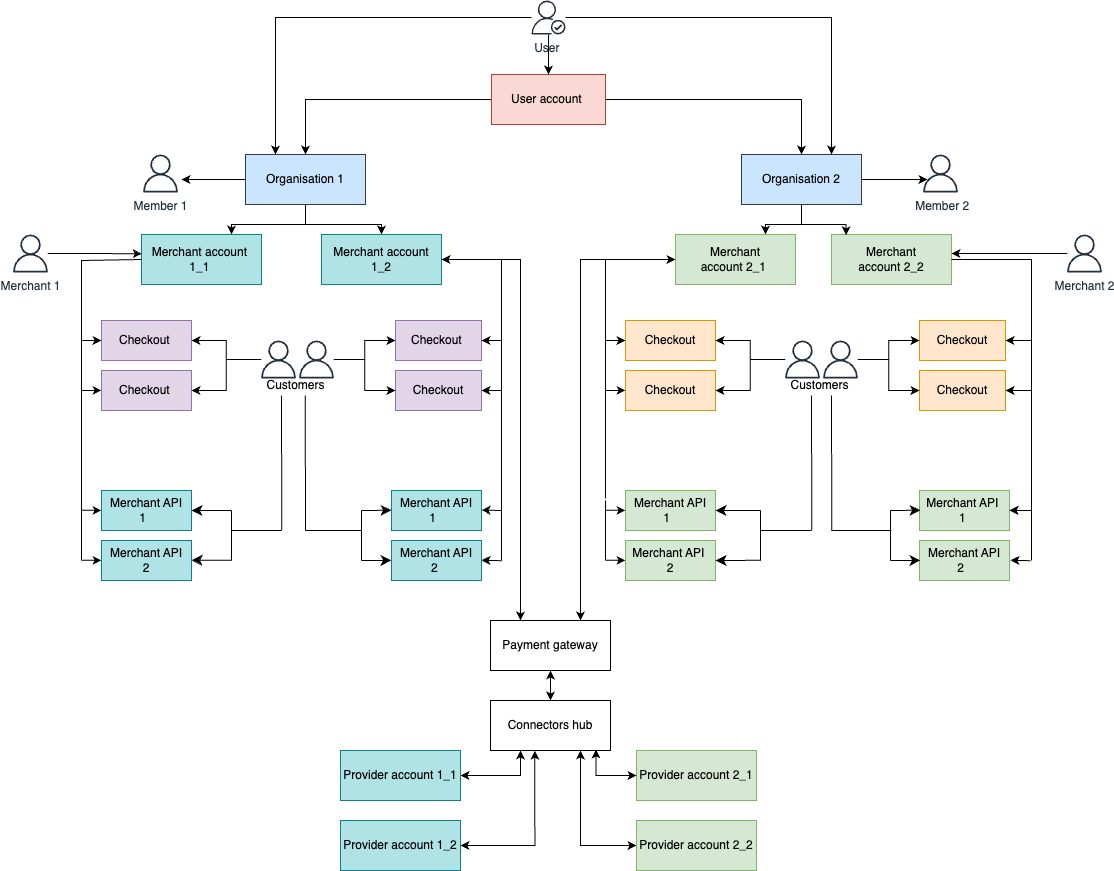Architecture
Discover the building blocks of our system, each in turn:

User account
When users register in our system, they create an Account, which serves as a first precondition for entering our system. It is the first significant brick in our structure. The Account is linked to one ID. You can also create multiple Organisations linked to one Account. To learn more about the interdependence between the Account and the Organisation, go to Account personalisation.
Organisation
Organisation is an element in our structure related to a particular business case. On the Organisation level, users become Members and perform specific Roles based on the permissions. The Owner of the Organisation is a user who primarily created it in the system. One Organisation involves multiple Merchant accounts. To learn more about the Organisation, go to Organisation settings.
Merchant account
A Merchant account is an element that represents a separate business unit of a particular Merchant. You can create multiple Merchant accounts under one Organisation. You can accept the payments and initiate the payouts in a Merchant account. Therefore, it is possible to add the applicable Payment and Payout schemes. One Merchant account can be linked to multiple Checkouts. Also, you can make the integrations via APIs and Webhooks.
- Webhooks are the elements that help to check the status and the progress of the payment without making any extra requests.
- Merchant API defines the private interface that allows initiating Host-to-Host interactions.
Merchant members
Merchants are the actors that create Merchant accounts. One Merchant can have several business units and thus create multiple Merchant accounts in our system accordingly. Merchants can perform different actions in a Merchant account, namely, review analytics, change profile settings, update currencies, and add Payment and Payout schemes.
Customers
Customers are the actors who directly interact with the Checkouts linked to particular Merchant accounts. One Merchant account can cover several Checkouts. Customers can make payments and choose the Payment methods at Checkout.
Provider account
Provider account is an account created on the provider side, which lies between the Merchant and the Payment processing network. It is linked to the Acquirer bank with specific account credentials. In our ecosystem, the data from the Provider account is stored to the Merchant account via the Payment gateway.
Payments
The Payments section consists of three main elements, namely:
- Payment Request is the highest-level entity in the payment gateway. It was created to reflect the payment in the Merchant system. Only Merchants can generate a Payment request.
- Payment Commit is the operation that reflects the Customer’s payment action and contains the Method and Method fields selected by the Customer.
- Payment Transaction is the entity that reflects the payment on the Provider side. Its main task is to control the payment process by checking the sequence of payment commands on the Provider, status transitions.
Tokens
Tokenisation is a secure way to save and use a preferred Payment method for all your subsequent payments. Thanks to Tokens*, the Merchant does not need to store sensitive data; instead, the Merchant stores the access key to these data. Thus, the Token can carry out write-offs on saved cards. As a result, it increases the conversion since the user does not need to enter card data manually each time they make a payment.
Payment methods
Payment methods are the ways in which Merchants can proceed with customer payments. In this respect, we emphasize a smooth Сheckout process, which leads to higher conversion rates.
The Payment methods that Corefy supports:
- Credit cards
- Bank transfers
- Digital wallets
- Cryptocurrencies
- Mobile carriers
- Utility bills
- Local payment options
Updated about 2 months ago
